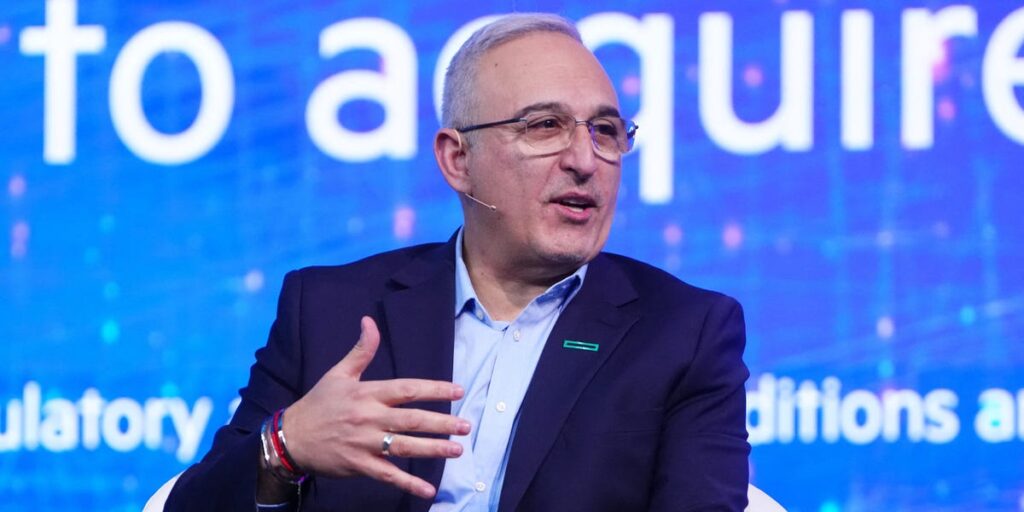- Hewlett Packard Enterprise CEO Antonio Neri prioritizes diversity, equity, and inclusion.
- Neri’s DEI focus contrasts with companies like Microsoft and John Deere reducing such efforts.
- Neri’s leadership style is shaped by his immigrant background and starting in HP’s call centers.
Hewlett Packard Enterprise CEO Antonio Neri started his career at the company as a “Customer Service Engineer” in a call center nearly 30 years ago. Today, that experience informs his commitment to diversity, equity, and inclusion.
“Intentionality is important,” Neri said in a recent interview with Business Insider.
HPE has a workforce of more than 62,000 — double the size of Nvidia’s, but it has nowhere near the name recognition, especially since it split off from HP in 2015. HP makes computer printers for homes and offices. HPE provides data center and cloud service services and technology to businesses.
Focusing on company culture was number two on Neri’s list of top three priorities across the company this year, he told BI, and diversity plays a big part. (Innovation was number one).
That sets him apart in the fast-shifting climate for corporate DEI. The list of companies ranking DEI that high may be shrinking. Microsoft laid off one of its diversity, equity, and inclusion teams earlier this year, citing “changing business needs.”
In August, Harley Davidson announced an end to its effort to buy from diverse suppliers, and John Deere said in July it would not “participate in or support external social or cultural awareness parades, festivals, or events.”
A survey by the executive search firm Bridge Partners of 400 C-suite and HR leaders at companies with either at least $25 million in revenue or 250 employees found that the number of employers who said they had increased their DEI investments in the past year dropped to 66% in 2024 from 77% in 2023. Roughly one in four executives expressed a belief that DEI programs were a fad.
“My first job at HP was in a call center where we had 21 different languages and probably 40 different nationalities and every gender — every presence you can imagine,” Neri said. “That was a fun place to work and we were a very high-performance team. So, to me, this is a natural way to do things,” he continued.
When he took over the CEO job in 2018, all 12 of Neri’s direct reports were male. It took seven years, but that group is now 50% female and so is HPE’s board. Across the company, women hold nearly 28% of director-level or above positions, according to the company’s 2023 ESG report.
Neri said he addresses DEI initiatives at the company in internal quarterly leadership discussions and company surveys multiple times a year. He’s received no pushback on the company’s efforts in this area, he said.
On top of diversifying hiring, Neri likes to see employees moving up the ranks relatively fast.
“We need to look for the diamond in the rough in order to challenge people to continue to grow,” he said. The younger generations, he said are often more “restless” for challenge.
HPE measures and rewards managers based on the diversity of their hiring, retention, and promotion of employees — especially at higher levels.
Letting employees coast in their comfort zones isn’t on the agenda. In fact, he credits his rise to CEO in part to people who recognized his talent early on and pushed him into promotions he wasn’t necessarily looking for.
The CEO role has changed
The 57-year-old CEO wants a diverse workforce that stays with the company and moves up the ranks. And those goals are baked into managers’ performance metrics.
“Ultimately it’s a part of succession planning. Who’s going to be the next CEO down the road? It could be somebody from inside,” Neri said.
Neri took over the top spot at HPE from Meg Whitman, formerly CEO of eBay and current US ambassador to Kenya, seven years ago, and he said his experience of the job is very different from hers.
“The role of CEO has changed dramatically from what we knew a decade ago,” Neri said. CEOs are asked to take positions now on issues that matter to employees.
He wants to hear strong opinions internally too, he said, and he’s not afraid to follow them and fail fast when it comes to innovation.
“I need people to have an opinion. If you’re sitting on the sideline, that means you’re you’re not contributing your best,” he said.
Read the full article here


